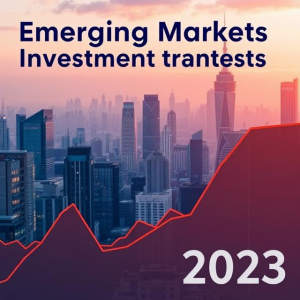Introduction
Emerging markets (EMs) are poised for a transformative 2023, offering investors a blend of high-growth opportunities and complex challenges. With IMF projections signaling 4.0% GDP growth for EMs—outpacing advanced economies—savvy investors are recalibrating strategies to capitalize on trends like digital disruption, renewable energy, and a booming middle class. However, risks like currency volatility, geopolitical instability, and rising U.S. interest rates demand cautious optimism. This guide unpacks actionable emerging markets investment strategies for 2023, tailored to maximize returns while mitigating risks.

Why Invest in Emerging Markets in 2023?
Emerging markets are no longer a peripheral bet but a core component of global portfolios. Here’s why:
- Demographic Powerhouse: 90% of the global population under 30 resides in EMs, driving consumption in India, Nigeria, and Indonesia.
- Tech Innovation: Digital payment adoption in Brazil (Pix) and India (UPI) grew by 150% in 2022.
- Commodity Strength: Latin American energy exporters (Brazil, Colombia) and Gulf oil producers (Saudi Arabia) benefit from elevated prices.
Key Risk: The U.S. Federal Reserve’s rate hikes could trigger capital outflows. Mitigate this by diversifying across regions like Southeast Asia and the GCC.
(LSI Keywords: “demographic dividend,” “capital outflows,” “Federal Reserve rate hikes”)
Top Emerging Markets Sectors for 2023
Tech & Digital Economy
From India’s $1 trillion digital economy goal to Africa’s fintech boom (Flutterwave, MTN Mobile Money), tech is reshaping EMs. Actionable Strategy: Invest in ETFs like EMQQ Emerging Markets Internet & Ecommerce ETF or stocks like MercadoLibre (Latin America’s e-commerce leader).
Renewable Energy
Countries like Vietnam (solar) and Chile (lithium) are critical to the global energy transition. ESG Opportunity: Green bonds in Brazil (wind farms) and UAE (solar parks) offer yields above 6%.
(Keywords: “renewable energy ETFs,” “ESG opportunity,” “green bonds”)
Geopolitical Risks in Emerging Markets
2023’s top risks include:
- China-Taiwan Tensions: Could disrupt semiconductor supply chains.
- Russia-Ukraine War: Impacts wheat imports for Egypt and Turkey.
- Latin American Elections: Mexico and Argentina face policy shifts.
Mitigation Strategy: Use currency-hedged ETFs (e.g., WisdomTree Emerging Markets ex-China Fund) and diversify into politically stable markets like India.
(LSI Keywords: “currency-hedged ETFs,” “supply chain disruption”)
ESG Investing in Emerging Markets
ESG integration is critical in EMs, where governance gaps can derail returns. Focus on:
- Transparency Leaders: Taiwan Semiconductor (green manufacturing) and Safaricom (Kenya’s renewable initiatives).
- Avoid: Coal-dependent utilities (Eskom, South Africa) or deforestation-linked palm oil (Indonesia).
(Keywords: “ESG investing,” “governance gaps,” “renewable initiatives”)
Active vs Passive Strategies
- Passive: Low-cost ETFs like VWO (Vanguard FTSE Emerging Markets) provide broad exposure but overweigh China (33% of MSCI EM Index).
- Active: Funds like T. Rowe Price Emerging Markets Stock Fund target undervalued sectors (e.g., Mexican industrials).
2023 Tip: Blend both strategies to balance cost and alpha generation.
China’s Role in 2023
China’s uneven post-COVID recovery demands selectivity:
- Opportunities: EV giants (BYD), luxury consumption (Kweichow Moutai).
- Risks: Property sector debt (Evergrande) and U.S.-China tech decoupling.
Strategy: Underweight China relative to indices and favor ASEAN alternatives.
Debt Markets
EM sovereign bonds offer yields up to 15% (Egypt, Pakistan) but carry default risks. Prioritize:
- Short-duration bonds to hedge rate hikes.
- Investment-grade corporates like Petrobras (Brazil) and Reliance Industries (India).
Frontier Markets
Frontier markets (Bangladesh, Kenya) offer untapped potential:
- Bangladesh: Garment exports and solar energy projects.
- Vietnam: Graduating to EM status with 6.5% GDP growth.
ETF Pick: FRN (Invesco Frontier Markets ETF).
Conclusion
Emerging markets in 2023 demand a nimble, research-driven approach. Prioritize sectors aligned with global megatrends (tech, green energy), hedge geopolitical risks, and leverage ESG frameworks to ensure sustainable returns.